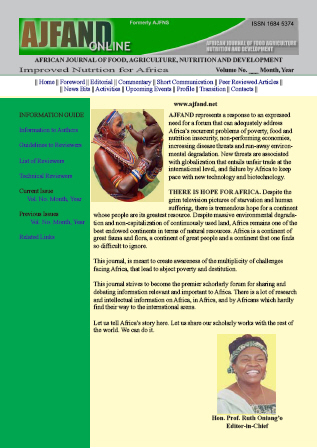
|
African Journal of Food, Agriculture, Nutrition and Development
Rural Outreach Program
ISSN: 1684-5358
EISSN: 1684-5358
Vol. 20, No. 3, 2020, pp. 15919-15935
|
 Bioline Code: nd20045
Bioline Code: nd20045
Full paper language: English
Document type: Research Article
Document available free of charge
|
|
|
African Journal of Food, Agriculture, Nutrition and Development, Vol. 20, No. 3, 2020, pp. 15919-15935
| en |
SOCIO-DEMOGRAPHIC DETERMINANTS OF ACCESS TO SANITATION FACILITIES AND WATER IN THE NAMIBIAN RURAL AREAS OF OMAHEKE AND OSHIKOTO REGIONS
Mosimane, AW & Kamwi, JM
Abstract
Access to water and sanitation is an important basic need of human beings. However, inadequate access to sanitation facilities and water is a critical challenge in sub-Saharan Africa. The understanding of the socio-demographic factors of rural households to access water and sanitation services across spatio-temporal scales is nascent in developing countries, including Namibia. The present study examines the potential explanatory socio-demographic variables which determine the use of sanitation facilities and access to water in rural communities of Namibia using Omaheke and Oshikoto Regions as case studies. The study was cross-sectional and used quantitative data collection tools. Specifically, the study used structured questionnaires to collect data from 137 households, which were randomly selected in the study regions. Data were entered and analysed using the Statistical Package for Social Sciences (SPSS version 21). The association between the socio-economic data and access to sanitation and water was analysed using the multinomial logistic regression. Pearson’s correlation was used to evaluate the correlation between the explanatory variables. The results revealed that there is a significant difference (p<0.05) in the types of water facilities used in Oshikoto and Omaheke regions. There is no significant influence of gender and age on access to sanitation facilities (p>0.05) in the study areas. Education significantly influenced the choice of piped tap water in the yards (p<0.05) and there was no significant influence of gender, age and education to access other water facilities (p>0.05). The study further found that the reliability (water interruptions) of sanitation and water services and the distance to facilities negatively impacted access to sanitation and water services in the study regions. The study concludes by underscoring the implications of different socio-demographic variables on accessing and accepting various water and sanitation facilities. This analysis enables effective decision making to reconcile the efforts of sustainable development, sanitation and water resource management in Namibia and other countries with a similar set of socio-economic and demographic conditions.
Keywords
access; sanitation; water; facility; community; management; Oshikoto; Omaheke
|
| |
© Copyright 2020 - African Journal of Food, Agriculture, Nutrition and Development
Alternative site location: http://www.ajfand.net/
|
|
